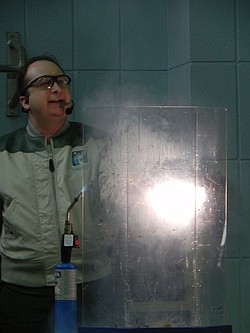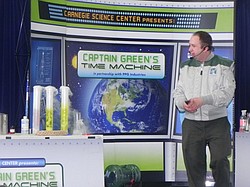Watson elementary students get a visit from Captain Green
Neighbors | Sarah Foor .During a visit to Watson Elementary from the Carnegie Science Center on March 12, host Mike Hennessey showed off a chemical reaction that wowed the students. Hennessey achieved the bright affect by lighting magnesium on fire and placing the ignited liquid between two pieces of dry ice.
Neighbors | Sarah Foor .Carnegie Science Center educator Mike Henessey (right), referred to as Captain Green during a March 12 presentation at Watson, showed how carbon dioxide can bleach out colors in watery environments with an experiment (left). Hennessey explained how carbon dioxide and it's bleaching properties is affecting world habitats like the Great Barrier Reef.
By SARAH FOOR
Watson students learned about the importance of caring for the environment during a visit from the Carnegie Science Center on March 12.
Captain Green, played by Carnegie educator Mike Hennessey, taught students the history and science of climate change, as well as exploring the human innovations helping to provide sustainable resources.
Hennessey began his presentation by explaining how different kinds of energy is harnessed for our use.
“Often, coal is burnt off to heat water. That water helps produce electricity in power plants, which is why the lights turn on in our house. The system works, but burning coal puts a lot of harmful carbon dioxide in the environment. We can replace coal in this process with wind turbines or solar panels, which are much better for the earth,” Hennessey explained.
Captain Green showed students how carbon dioxide and other greenhouse gases harm the environment with interactive, exciting experiments.
High levels of carbon dioxide have “bleached” some of the brilliant colors of the Great Barrier Reef. Hennessey dropped a solid form of carbon dioxide, also known as dry ice, into colored water during the presentation and students watched as it leeched the colors away within minutes.
The Carnegie presentation helped students learn preventative tips and asked to take control of “Spaceship Earth” and reduce their carbon footprint. Captain Green said conservation, technology, and small everyday choices by Watson students and their families could help provide a more sustainable future.
At the close of the event, Hennessey said he hoped the students would consider their futures in many different ways thanks to the visit.
“We’re proud that our presentation features many local scientists and we hope we inspired the kids to think about a future in a science career. Someday, these students will become the kind of experts we need in this area to continue to find creative solutions for climate change,” the educator said.
 43
43


